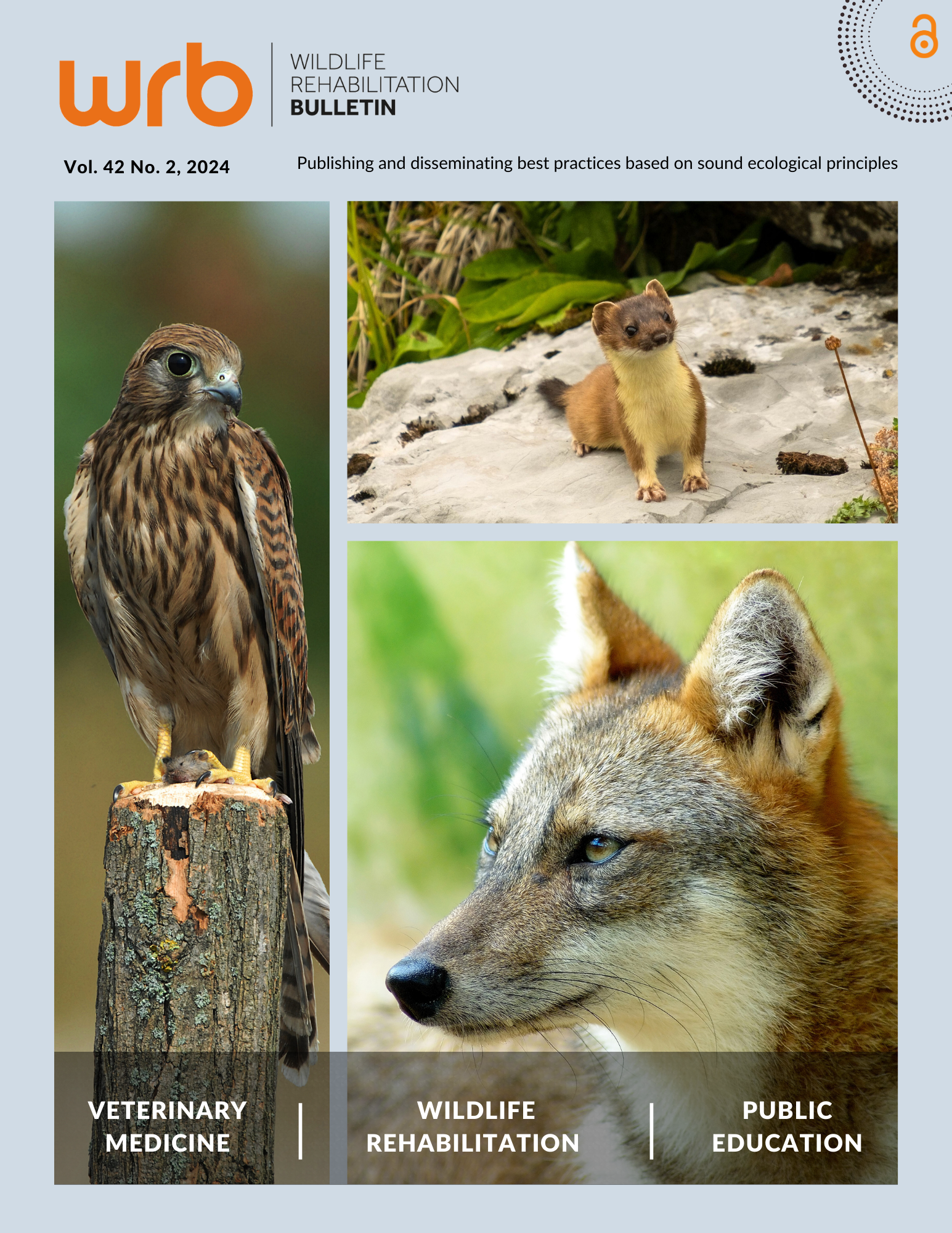Rehabilitation and release of orphan golden jackal pups (Canis aureus)
DOI:
https://doi.org/10.53607/wrb.v42.267Keywords:
Golden jackal, Canis aureus, nursing, wildlife rehabilitation, post-release monitoringAbstract
Hand-raising wildlife orphans require expertise and knowledge of the species
concerned. In this paper, we describe the successful hand-raising of three
golden jackal pups subsequently released back to the wild. The pups were
nursed using a commercial canine milk replacer for puppies. The average
weight gain of the jackal pups was 3.96 g (±0.32) per day during the milk
feeding period and 22.71 g (±1.03) per day after they were weaned and solid
food was given. They were housed in a medium-sized cage (48 × 36 × 36 in)
with a refuge den until they were 3–4 months old and then moved to a larger
outdoor enclosure (22 × 10 × 10 ft). To create fidelity to the release site, they
were held in a transit cage (8 × 6 × 6 ft) for 36 days at the release site. They
were about a year old at the time of release. Two of them (male and female)
were radio-collared, but the collars failed the day after release. The females
moved away from the male four days post-release, as evidenced by the camera
trap images. The male was sighted two months post-release with the damaged
collar on, but the fate of the two females could not be ascertained. Data on the
post-release survival and ranging pattern could not be established due to the
compromised radio collars.
Downloads
References
Baro, D., Ali, S. and Choudhury, B. 2022. Surgical management of olecranon bursitis in four hand-raised golden jackals (Canis aureus). Veterinary Practitioner, 23, 350-352
Dhoot, V. M., Upadhye, S. V., Zinjarde, R. M. and Pande, M. R. 2003. Hand-rearing of jackal (canis aureus) at Maharajbag zoo, Nagpur. Zoos'print journal 18(1), 995-996.
Gage, L. J. 2008. Hand-rearing wild and domestic mammals. John Wiley & Sons.
Giannatos, G., Marinos, Y., Maragou, P. and Catsadorakis, G. 2005. The status of the golden jackal (Canis aureus L.) in Greece. Belgian Journal of Zoology 135,145–149.
Hoffmann, M., Arnold, J., Duckworth, J.W., Jhala, Y., Kamler, J.F. and Krofel, M. 2018. Canis aureus (errata version published in 2020). The IUCN Red List of Threatened Species 2018: e.T118264161A163507876. https://dx.doi.org/10.2305/IUCN.UK.2018- 2.RLTS.T118264161A163507876.en
Jhala, Y.V., and P.D. Moehlman. 2004. Golden Jackal Canis aureus Linnaeus, 1758. Pp. 156-161 in Canids: Foxes, Wolves, Jackals and Dogs. Status Survey and Conservation Action Plan (C. Sillero-Zubiri, M. Hoffmann, and D.W. Macdonald, editor). IUCN/SSC Canid Specialist Group, Gland, Switzerland and Cambridge, UK.
Joshi, P., Koladiya, M.H. and Gajera N.B. 2015. Population Status and Habitat use by Golden Jackals in semi-arid Landscapes of Western Kachchh, India. International Journal of Recent Scientific Research 6 (4), 3507-3510.
Moehlman, P. D. 1987. Social Organization in Jackals: The complex social system of jackals allows the successful rearing of very dependent young. American Scientist 75(4), 366–375. http://www.jstor.org/stable/27854716
Mohapatra, R.K., Sahu, S.K., Das, J.K. and Paul, S. 2019. Hand rearing of wild mammals in captivity. Nandankanan Biological Park, Forest and Environment Department, Government of Odisha. 1-80.
Negi, T. 2014. Review on current worldwide status, distribution, ecology and dietary habits of golden jackal, Canis aureus. Octa Journal of Environmental Research 2(4), 139-159
Pillay, R., Johnsingh, A. J. T., Raghunath, R. and Madhusudan, M. D. 2011. Patterns of spatiotemporal change in large mammal distribution and abundance in the southern Western Ghats, India. Biological Conservation 144(5), 1567-1576.
Trendler, K. 2005. The principles of care and rehabilitation of orphaned wild mammals. Pp. 46-53 in Back to the Wild, Studies in Wildlife Rehabilitation (V. Menon, N.V.K. Ashraf, P. Panda, and K. Mainkar, editor). Conservation Reference Series 2. Wildlife Trust of India, New Delhi.
Published
How to Cite
Issue
Section
Categories
License
Copyright (c) 2024 Daoharu Baro, Bhaskar Choudhury, Samshul Ali, Nazrul Islam, Rathin Barman, Prabhat Basumatary

This work is licensed under a Creative Commons Attribution-NonCommercial-NoDerivatives 4.0 International License.
The copyright for articles in this journal is retained by the author(s), with first publication rights granted to the Wildlife Rehabilitation Bulletin and NWRA. Articles published as open-access in this journal are free to use and share with proper attribution in educational and other non-commercial purposes. To obtain reprint permission for articles that are not open access, please contact the journal editor.







